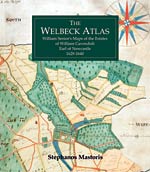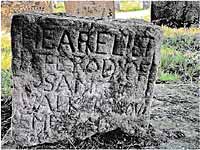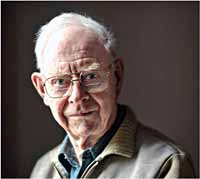News for Summer 2019
A positive book review!

The Welbeck Atlas received a very positive, indeed enthusiastic, review in a recent issue of the Journal of the International Map Collectors’ Society. The reviewer drew attention to a comment in the Preface by the editor of the volume, Steph Mastoris. Having apologised to all his readers for the slowness of appearance of the volume, Steph states that ‘After spending longer studying the Atlas than William Senior took to survey and create the original volume, I am... in awe of his achievement’. No comment needed!
Stapleford Cemetery Headstones Project
With the help and support of Stapleford and District U3A a group of volunteers have transcribed all the headstones in Stapleford cemetery. A book covering the older part of the cemetery has been produced that contains over 1200 inscriptions with an index and plan of the cemetery. The book can be found in Nottingham Local Studies library, Stapleford library, Nottingham Archives and the University Archives. The book also is on the internet and can be found at https://staplefordcemeterymemorials.wordpress.com/
Members of the public can search and see the transcripts free of charge. Later this year a second book will be available containing the rest of the cemetery and crematorium memorials, a further 1900 inscriptions. These will also be available at the libraries etc and on the website. On the website there is also the facility to send an email with any questions/queries or request further information.
Janet Cross
A Walesby Gravestone

The photograph shows a gravestone rescued from a heap of rubble in the churchyard at Walesby. It is most probably that of Rosamond Walker.
A copy of the Register of Walesby, complied by Rev. George W. Marshall LLD in 1898 records the following:
Baptisms 1580-1792; Marriages 1594-1753; Burials 15851791
The photograph clearly reveals the death to have taken place in November and the only surname that begins with WALK.. in the records is Walker which reads:
24 Nov. 1668 wife of James Walker.
There is no record of a marriage of James Walker but there is a record of the birth of a child:
25 May 1659 Ann d. James Walker and Rosamond
An examination of the letters of the first name in the photograph fit the name Rosamond.
Further research shows:
22 Oct. 1620 James Bullivant m. Eshabeth Taylor 8 Sep. 1622 Rozamon d. James Bullenant
To summarise - this is the oldest gravestone found to date in the graveyard of Walesby Church and is probably of:
Rosamond Walker 1622-1668, daughter of James and Eshabeth Bullenant and wife of James Walker.
Tony Spratley
Obituary - Dr Stephen Wallwork (1925-2019)

Dr Stephen Wallwork, a distinguished Chemist, and a historian of the Nottinghamshire community of Beeston, died in February 2019 aged 93.
Stephen Wallwork was born in Ashton-under-Lyne in 1925 and educated at Manchester Grammar School where he swapped from specialising in modern languages to science and mathematics [Chemistry]. He then gained a scholarship in chemistry to Brasenose College, Oxford, in 1943, researching alongside Margaret Roberts (later to become Prime Minister, Margaret Thatcher) and Dorothy Hodgkin (later a Nobel Prize winner). After graduating (first degree and D.Phil) in Oxford, he moved to Nottingham University where he joined the Department of Chemistry in 1949. He began as Assistant Lecturer and later rose through the ranks to become Senior Lecturer and then Reader. He also spent a year as Acting Head of Department, in Physical Chemistry. With the support of Professor F. E King, Head of Chemistry when Stephen was first appointed, he set up the X-Ray Crystallography department. There was no X-Ray Crystallography research at Nottingham University before his appointment. He started with a project fund of £1,000, in a 3m2 laboratory which also served as his office.
During his time at Nottingham, Stephen published over 80 papers on his crystallographic research and in 1956 a book Physical Chemistry for Students of Pharmacy and Biology, which was translated into Spanish and Japanese, as no book at the time presented physical chemistry in a sufficiently understandable way for non-physical scientists.
Stephen’s work in crystallography led him to become secretary of the Crystallographic Group of the Institute of Physics, and the Chemical Crystallography Group of the Royal Society of Chemistry. He also played a pivotal role in setting up in 1982 the British Crystallographic Association, from two committees he had helped form, the European Crystallography Committee and the United Kingdom Crystallographic Committee. By the 1980s, with retirement in sight, and with a growing interest in local history, particularly the history of Beeston, Stephen gradually shifted his range of interests, without ever abandoning either Chemistry or History.
In 1983 the University advertised an M.A. in Local and Regional History, and Stephen was one of the first cohort of students. For someone with no qualifications in History, and no known previous desire to study the subject, this was a considerable risk. Stephen told his tutors that he did not expect special treatment because he was on the University staff. He did not get it: his first essay was returned to him with instructions to rewrite it as a history essay rather than a scientific paper!
This was not, perhaps, the best start, but things could and did get better. Stephen brought to local history his scientific mind-set. His M.A. dissertation involved a careful reconstruction of the late sixteenth century outbreak of plague in Beeston. Demographic analysis of this type was still quite new - as indeed were computers - in historical research in the mid-1980s, and by using a statistical package to collect and analyse his data, Stephen brought something quite new into local history. He went on to use similar techniques to estimate the population of Nottingham prior to the decennial censuses beginning in 1801. All of this work was new in the 1980s: today it would simply be a matter of collecting data in Microsoft Excel and pressing a couple of keys to undertake the analysis as if by magic.
Stephen graduated with his second Master’s degree in 1985, aged sixty. He was first and foremost a scientist, but in local history he brought his orderly mind to what was disparate and often inconsistent data. This was clear in the work he undertook with Geoffrey Drinkwater. Beeston has an enclosure map from 1809 showing how the fields were laid out following Parliamentary enclosure. But no one knew what the pattern was prior to 1809 until Stephen and Geoff found a way of reconstructing the pre-enclosure village using data from documents which enabled them to trace the open field furlongs, and then to map the material. The results of their findings were set out in articles published in The Nottinghamshire Historian in 2002 and 2007. These showed how a scholar from outside the discipline of History can make a telling contribution to the subject using skills developed in another subject area.
Stephen’s approach to research also served him well when, between 1985 and 1990, he held the position of Statistical Assistant in the Department of History at the University. This post, long since defunct, had originally been a position in the old (and equally defunct) Department of Economic and Social History. Stephen did not think much to History ‘statistics’ and referred instead to ‘numerical history’ but he undertook important work on Nottingham, and on the lace and hosiery trades (for Professor Stanley Chapman). He continued to help voluntarily in the History Department for several years after his second retirement.
Stephen became very knowledgeable on every aspect of the local history of Beeston and was one of the authors of the two historical trails published by the Beeston Civic Society. He was also much in demand as a popular lecturer on the history of Beeston, taught a WEA class on that subject and led the research efforts when that class became a research group.
Stephen was first and foremost a scientist but had a thirst for new, intellectual experiences, a desire to extend his skills and to be as helpful as possible to others, and an interest in problem-solving. He came to enjoy local history as a hobby to which he could bring his orderly mind and, in the process, make a real contribution to learning. Stephen was still publishing his historical research in 2018, his last on early land use in Beeston being published in the Nottinghamshire Historian in Autumn 2018, just a few months before he died.
Stephen’s publications in Local History are listed in the Nottinghamshire Bibliography Online.
John Beckett
May I add my own appreciation of Dr Wallwork? He lectured to a massed audience of biology and pharmacy students when I was an undergraduate at Nottingham in the early 1960s. I well remember his clear lectures, delivered with very precise speech, and his kindness to those students who could not grasp the arcane theories behind some of the physical chemistry syllabus. Sadly, I no longer have my copy of his book, referred to above by Professor Beckett, but I recall it as being very helpful.
John Wilson
Other long-standing members of the Thoroton Society who are no longer with us are Veronica Woodward and Pauline Miller.
Listed Buildings
There are now thousands of listed buildings in England encompassing a wide variety of types, ages and designs. The 400,000th, announced on 20th August 2018, is the former head office of the Raleigh Bicycle Company here in Nottingham. It is known as the Howitt Building, designed as it was by TC Howitt. As members will know, Howitt was also responsible for the Council House.
This newly listed building was originally built in 1931 for the Raleigh Bicycle Company as its luxurious head office but subsequently sold to Nottingham City Council in the ‘80s. Currently it is home to the Marcus Garvey Centre which provides support and other facilities for Nottingham’s African-Caribbean community, including a popular live music venue known as the Garvey.
A notable feature of the Howitt Building are the relief panels depicting cherubs engaged in varied activities associated with bicycle manufacture. Displayed on the building’s facade and above the doorways of the ballroom/concert hall, they are known as the “little Ians” as they were modelled on Howitt’s young son Ian - Ian was killed in the Second World War.
Barbara Cast
The Listing states -
Architectural interest:
- as a carefully-executed and well-preserved example of an inter-war office building, with high quality external and internal detailing;
- as an example of the work of the distinguished C20 Nottingham architect T Cecil Howitt, a number of whose major works are listed, including the Nottingham Council House and the Newton Building at Nottingham Trent University, both listed at Grade ll*.
Historic interest:
- as the flagship main offices for the Raleigh Cycle Company, built at the height of its commercial success as the world's leading manufacturer of bicycles in the early-mid C20;
- for its importance from the late C20 onwards to Nottingham's African Caribbean community, originally in respect of a landmark challenge to the company's then selective employment policy, and now, as a cultural and social support centre, and by whom the former Raleigh company concert hall has been transformed into a successful performance venue.